After ten years of ups and downs in the cryptocurrency world, I have profited greatly during bull markets and have fallen to rock bottom twice, nearly facing financial collapse. Now, I can earn a living from trading cryptocurrencies, having withdrawn over 8 million yuan for living expenses, while steadily holding 35 million in assets in my account. This journey has not been easy, and it all depends on persevering!
Behind this lies my in-depth study and practice of the classic moving average trading rules. It has allowed me to almost entirely capture the profit from my positions, deeply understanding the truth of 'simplicity is the ultimate sophistication'. I adhere to this trading system, and over time, it has become like my personal bank, continuously creating wealth for me.
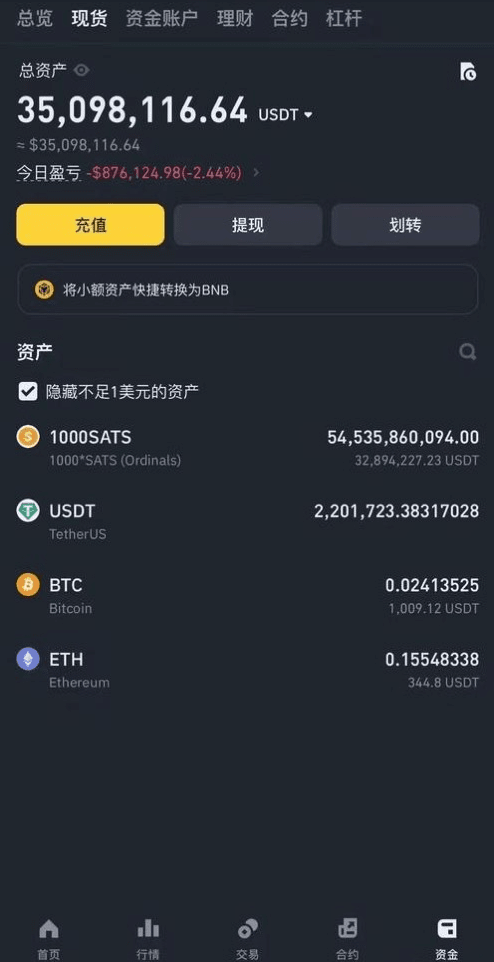
In trading, it is not only about seizing opportunities; learning to wait is even more important!
If you want to make money in trading, you cannot just focus on opportunities; you must know how to defend. Those who earn a lot and spend even more will always remain poor.
There is a saying that transcends time and space, meaning that in the past, present, domestically, and internationally, it is all the same. Jack Ma is rich, wearing cloth shoes; Li Ka-shing is also rich, wearing electronic watches. Zuckerberg, Musk, and Jobs all wear jeans and T-shirts.
Trading is the same; good opportunities are not abundant. When they come, you must seize them, that is skill.
If you made a lot of money in this wave, do not fantasize that the next wave will earn even more. This is an illusion; an increase does not necessarily mean a subsequent drop, and a drop does not necessarily mean an immediate rise.
However, after a large fluctuation, there will certainly be a small fluctuation. The futures market after the Spring Festival is very good for trading; you can easily multiply your gains.
Many stock traders are starting to trade futures; at this time, you need to be cautious, as the market in June and July will be very difficult for ordinary investors.
One is seeing that others are making money, which increases your desire; the other is that after a smooth market, there will definitely be a significant fluctuation. How to cope with it?
First, stick to one direction. If you trade both long and short, no matter how much you like heavy positions, I guarantee that you will be slapped back and forth within two months, losing everything.
Second, regardless of which direction you take, do not chase the market; chasing market entry does not have a cost advantage. In a smooth market, this small disadvantage will be covered up, but in a fluctuating market, it becomes deadly poison.
Third, select opportunities carefully. When the market is good, you can do anything, but future market conditions will be tough. If you still think that there are opportunities everywhere and want to try every variety, you will surely feel painful even if you participate with stop losses.
Investing is your own business; you are the first responsible person. Trading is not mysterious, but you must learn to assess the situation.
What was the best strategy during the three-year mask period? It was to stay put. Crazy expansion leads to faster demise; all principles of existence are interconnected.
Making money is about doing the right thing at the right time; both are indispensable.
So how can you excel in cryptocurrency trading? Once a person enters the financial market, it is difficult to turn back. If you are currently losing but still confused, and you plan to treat cryptocurrency trading as a second career, you must understand the 'Basic K-line strategies'. Understanding and grasping this will save you a lot of detours. These are personal experiences and feelings; I recommend saving and reflecting on them repeatedly!
The operational secrets of cryptocurrency experts—Basic K-line knowledge
Different K-line shapes often contain different signals; grasping these signals is the key to wealth.
Next, we will learn about two common K-line patterns: Doji; Hammer.

What is a doji?
The line type shown above is commonly referred to as a reversal doji. Whether it appears in a high price area or a low price area, it can be viewed as a signal for tops or bottoms, indicating that the trend is about to change its original direction.
There are several key points regarding doji stars that everyone needs to pay special attention to.
A doji is a special K-line pattern that indicates that the opening price and closing price are the same during that time period, appearing as a straight line. The appearance of this pattern indicates fierce competition between bulls and bears, neither willing to give in.
The lengths of the upper and lower shadows also provide very important guidance for the pattern; usually, the longer the shadow, the more intense the competition between bulls and bears. Once the trend is confirmed, the duration of the coin price trend will also be longer.
Doji stars usually have two functions: confirming the market trend and confirming a reversal. In these two cases, they are referred to as 'consolidation doji stars' and 'reversal doji stars'.
The consolidation doji star pattern is relatively small, with shorter upper and lower shadows, and often appears in the middle of a trend.
The scale of reversal doji stars is larger than that of consolidation doji stars (i.e., with longer upper and lower shadows), more often appearing at tops or bottoms.
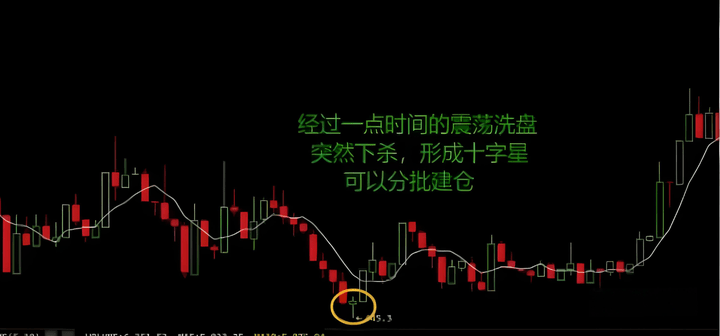
Additionally, there are other factors to consider when using doji stars to judge market conditions.
First
The position of the doji star (relative to the top, middle, bottom).
Second
Trading volume (is it accompanied by increased volume?)
Third
Are there multiple doji stars? (If many appear, the reference significance is greater)
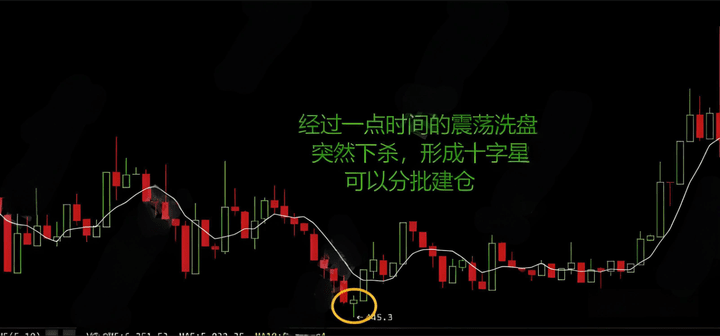
This concludes the discussion on doji stars. Next, I will talk about hammer lines. After that, I will send some charts of doji star patterns for everyone to review.
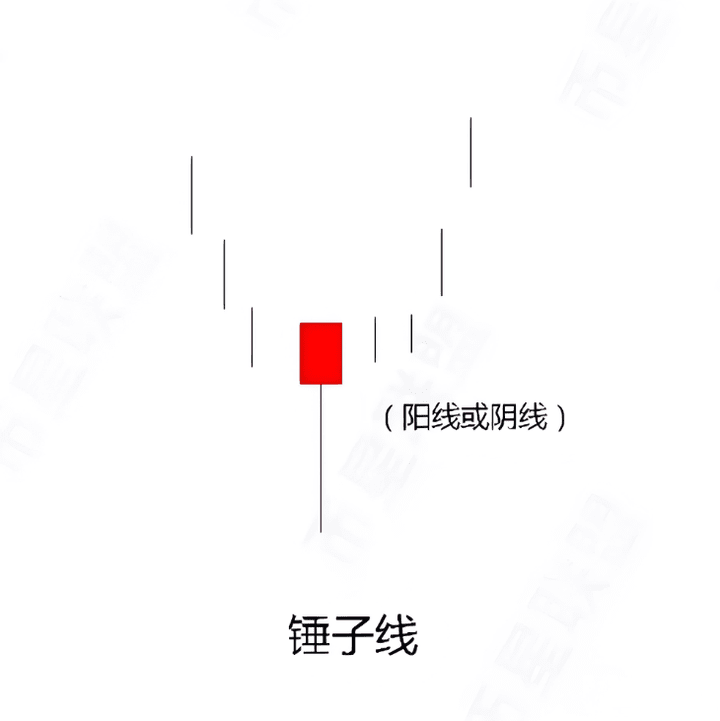
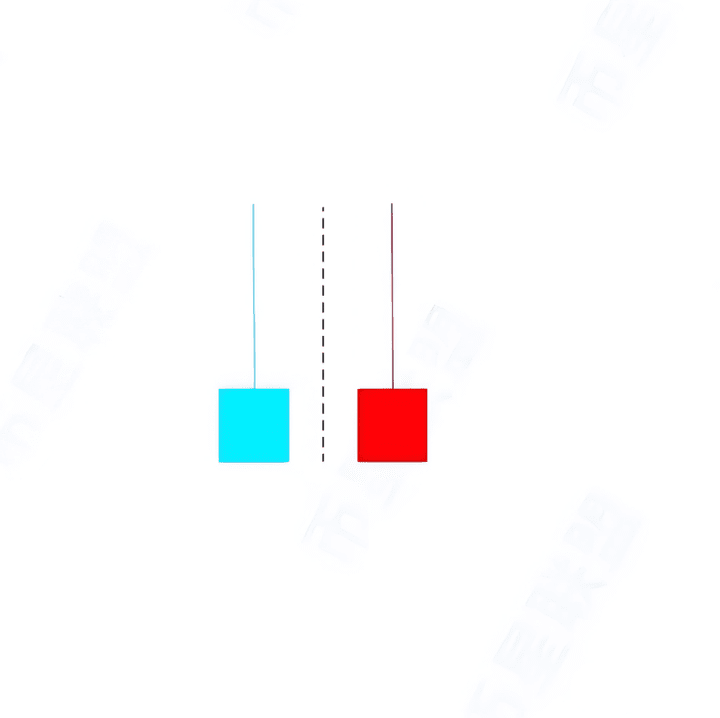
These two images show the standard forms of hammer lines: the regular hammer and the inverted hammer.
The hammer line has a longer lower shadow and a smaller body, and its body is located near the top of its entire price range, appearing in a descending trend K-line. It signals the end of the downtrend.
The characteristics of hammer lines include the following points:
First
In a downtrend.
Second
In K-lines, the small body should have the highest price and closing price at the top of the candlestick, with the opening price not far below the highest price, and the lower shadow being significantly long. The body color does not matter.
Third
There should be no upper shadow, but short ones are allowed. It is generally believed that the lower shadow should be 2-4 times the body.
Fourth
The longer the lower shadow and the shorter the upper shadow, with a smaller body, the more effective this type of candlestick is.

Next, let’s talk about how to use hammers to help us trade:
1. The smaller the hammer body and the longer the lower shadow, the more obvious the effect of stopping the decline.
2. The longer the stock price falls and the greater the amplitude, the more obvious the effect of stopping the decline.
3. Bullish hammer lines carry a bit more strength than bearish hammer lines.
Aggressive investors can try going long, while conservative investors can observe for a few days after the hammer line appears. If the coin price can increase significantly, they can go long.
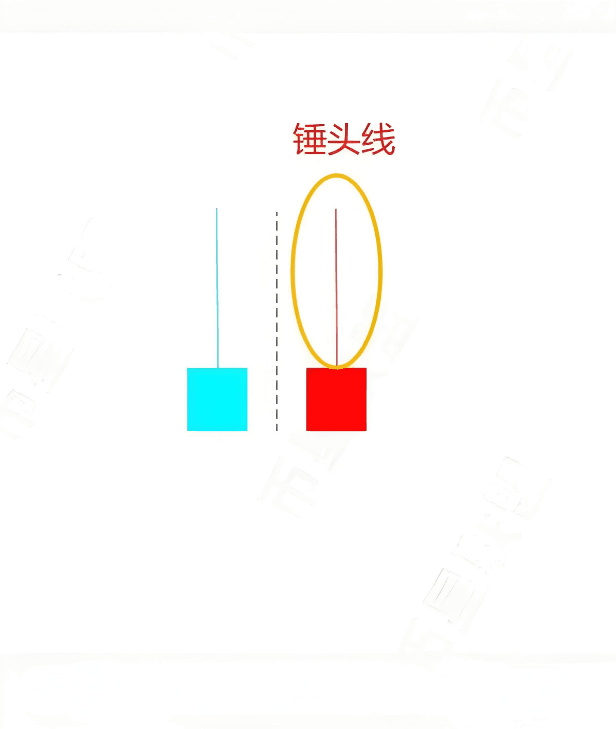
The above image is the hammer line we will learn next.
A hammer is an important reversal signal that often only makes sense after a significant drop or in a severely oversold situation. If it occurs after a two to three-day decline, it usually has no special significance.
Additionally, rebounds initiated by hammers are likely to face selling pressure, so the upward trend often pulls back to retest the bottom of the hammer, forming a W-bottom pattern.
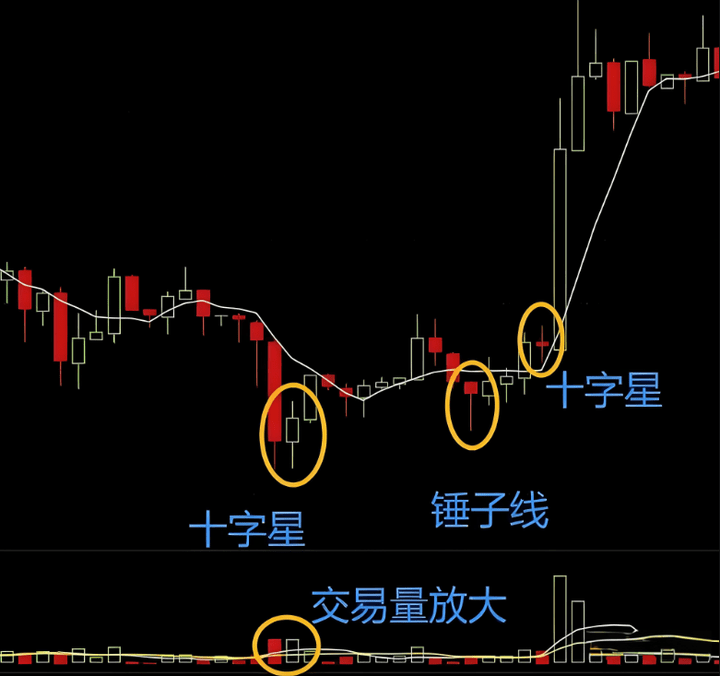
The above image is a typical case, which includes doji stars, hammer lines, trading volume, and W-bottom.
The first doji appears in a downtrend, accompanied by increased volume; it is highly probable that many retail investors, who were scared, are cutting losses and leaving the market.
After a rebound, there is another price drop, resulting in a hammer line. At this time, we can boldly predict that a W-bottom is about to form, and aggressive players can open a small position.
Immediately after, a large bullish candle breaks through several moving averages (some moving averages are hidden in the image for clarity regarding doji and hammer patterns).
Then there appears a doji, which is what we referred to earlier as the 'consolidation doji'. It further confirms the upward trend.
Any technical pattern indicator requires continuous review to find a trading method and strategy that suits you. You should look at K-lines more often; you can take a look at past K-lines and make judgments based on learning content. However, learning K-lines is not for short-term trading; it mainly helps you understand information that was previously unclear, and to know what some indicators represent.
Finally, I will share a set of trading insights!
Do you want to achieve stable profits in cryptocurrency contract trading?
1. Selection of trading targets
Mainstream first: Focus only on BTC and ETH, avoiding interference from altcoins.
Liquidity advantage: Mainstream coins have strong liquidity and lower trading risks, making them more suitable for high selling and low buying strategies.
2. Short selling strategy
Entry points: Pay attention to key moving average resistance levels on the 4-hour chart, such as MA60.
When MA60 continuously suppresses the price, you can gradually build short positions near this moving average.
Stop-loss settings: Set stop-loss points at the previous high position after the price spikes and falls back.
For example: If the resistance level is at 2440, and the price briefly spikes to 2450 before falling back, the stop loss can be set just above 2450.
3. Long strategy
Entry points: Choose the same level or higher support levels to gradually enter long positions.
Stop-loss settings: Set at the previous low position after the price spikes and rebounds.
For example: If the support level is at 2320 and the price briefly drops to 2310 before rebounding, a stop loss can be set below 2310, near 2300.
4. Capital management
Daily stop loss control: The maximum daily loss should not exceed 20% of the total principal. If it reaches 20%, trading will be paused for the day.
Single trade stop loss: Control individual losses within 10% of the capital to avoid impacting the overall account.
Balanced position: All opened positions should be consistent, avoiding increased risk due to excessive position size.
5. Trading discipline
Trading hot coins: Pay attention to hot coins when the market trend is good, but still strictly control risks.
Profit-loss ratio setting: It is recommended to set the profit-loss ratio at 3:1 to ensure profits greatly exceed losses.
Daily drawdown limit: If daily losses reach 10%-15%, trading will be paused to maintain rational operations.
6. Dealing with market crashes
Maintain an empty position: In extreme market conditions, do not blindly try to catch the bottom; patiently wait for clear market signals.
Rational waiting: When there are no suitable opportunities, it is better not to trade to avoid unnecessary losses caused by emotional fluctuations.
7. Profit-taking and stop-loss strategies
Break-even stop loss:
If the K-line pattern stabilizes after opening a position, you may temporarily avoid setting a break-even stop loss; if the pattern is broken or adverse signals appear, adjust the stop loss to the break-even point in a timely manner.
For example: Set a break-even stop loss after ETH gains 20 points; set a break-even stop loss after BTC gains 350 points.
Mobile profit-taking:
Use 3/5-minute K-line dynamics to adjust stop-loss levels and lock in floating profits.
For example: Start a mobile stop-loss strategy after ETH gains 35 points and BTC gains 500 points.
8. Trading mindset
Avoid gambling: Pursue stable profits instead of overnight wealth.
Overcome greed: Stay calm and operate rationally; do not blow up your account due to momentary greed.
💎 Summary
This set of blockchain contract trading strategies combines technical indicators, risk control, and capital management, suitable for stable trading of mainstream coins (BTC, ETH). Market fluctuations are inevitable, but as long as you strictly adhere to trading discipline and stop-loss strategies, you can steadily profit from the volatility. Do you want to become the next cryptocurrency expert? Start with stable trading and seize every profit opportunity!
Finally, remember:
The cryptocurrency market is a marathon; stability far outweighs quick wins. Gains made by luck will ultimately be lost due to lack of skill. Only by incorporating position management into instinct can one survive in a harsh market.
Remember: As long as you are alive, you have the right to wait for the next round of reversal.
No matter how diligent a fisherman is, he will not go out to fish in a storm but will carefully guard his boat. This season will eventually pass, and sunny days will come! Follow me for both fish and fishing skills; the cryptocurrency door is always open. Only by going with the trend can you have a life that flows with it. Save this and keep it in mind!


